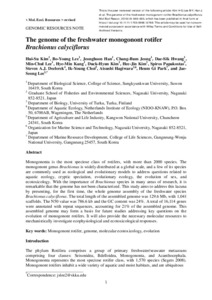The genome of the freshwater monogonont rotifer Brachionus calyciflorus
Hui‐Su Kim; Bo‐Young Lee; Jeonghoon Han; Chang‐Bum Jeong; Dae‐Sik Hwang. Min‐Chul Lee; Hye‐Min Kang; Duck‐Hyun Kim; Hee‐Jin Kim; Spiros Papakostas; Steven A. J. Declerck; Ik‐Young Choi; Atsushi Hagiwara; Heum Gi Park; Jae‐Seong Lee
https://urn.fi/URN:NBN:fi-fe2021042719039
Tiivistelmä
Monogononta is the most speciose class of rotifers, with more than 2,000 species. The monogonont genus Brachionus is widely distributed at a global scale, and a few of its species are commonly used as ecological and evolutionary models to address questions related to aquatic ecology, cryptic speciation, evolutionary ecology, the evolution of sex and ecotoxicology. With the importance of Brachionus species in many areas of research, it is remarkable that the genome has not been characterized. This study aims to address this lacuna by presenting, for the first time, the whole‐genome assembly of the freshwater species Brachionus calyciflorus. The total length of the assembled genome was 129.6 Mb, with 1,041 scaffolds. The N50 value was 786.6 kb, and the GC content was 24%. A total of 16,114 genes were annotated with repeat sequences, accounting for 21% of the assembled genome. This assembled genome may form a basis for future studies addressing key questions on the evolution of monogonont rotifers. It will also provide the necessary molecular resources to mechanistically investigate ecophysiological and ecotoxicological responses.
Kokoelmat
- Rinnakkaistallenteet [27094]
